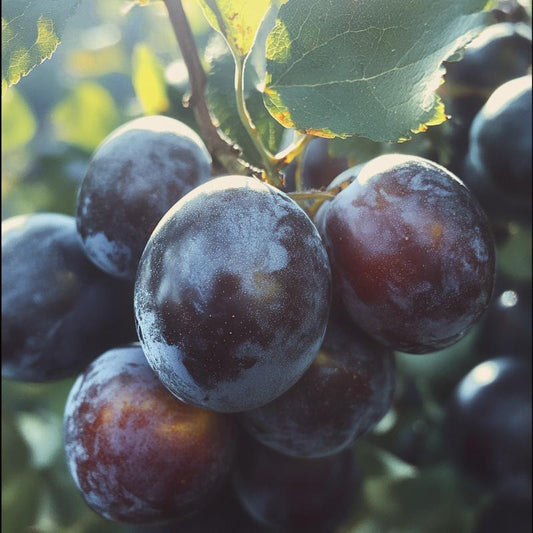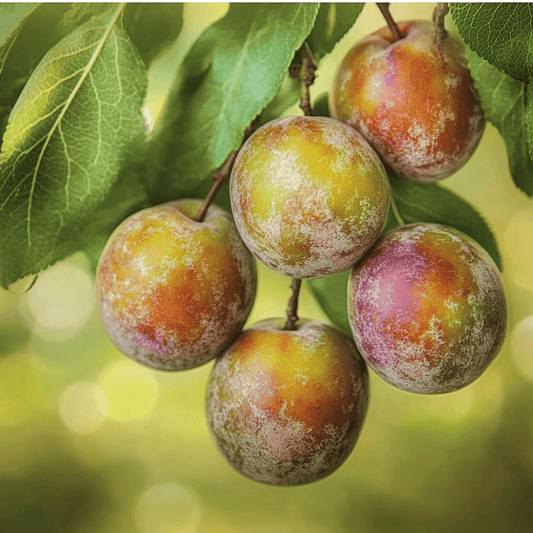Collection: Japanese and European Plum Trees
Our premium bare root plum trees include Japanese plums, European plums, and American plums, ideal for a wide range of growing conditions. These fruit trees are selected for their adaptability, cold hardy traits, and ability to produce delicious fruits with proper care.
Shipped as bare root, these trees establish quickly when planted in early spring. They thrive in full sun and well-drained soil, making them a reliable choice for home growers.
Popular Plum Varieties
Choose from top-rated plum varieties, selected for flavor, productivity, and regional adaptability:
-
Santa Rosa Plum Tree: A self-fruitful Japanese plum with large, sweet, and delicious plum. Perfect for zones 5-9.
-
Burgundy Plum Tree: Produces deep red plums with low acidity—great for fresh eating or preserving.
-
Italian Plum Tree: A traditional European plum, excellent for drying into prunes or enjoying fresh.
-
Satsuma Plum Tree: Juicy and richly colored, this Japanese plum benefits from cross-pollination.
-
Mariposa Plum Tree: A cold hardy, disease-resistant tree producing sweet, red-fleshed plums.
Most of our trees belong to the Prunus domestica species, known for producing high-quality European plums and hybrids suited to a variety of climates.
Proper Care for Plum Trees
To help your plum trees grow strong and productive:
-
Planting: Set your bare root tree in full sun with well-draining soil in early spring
-
Pruning: Shape the tree during dormancy to promote airflow and structure
-
Watering: Keep the soil consistently moist, especially during dry periods
-
Fertilizing: Use a balanced fertilizer in spring
-
Pollination: Some, like Santa Rosa, are self-fruitful, while others need compatible plum varieties nearby
Common Challenges and Solutions
-
Frost Damage: Late frosts may harm blossoms—opt for cold hardy types
-
Pests & Diseases: Watch for plum curculio, aphids, and brown rot. Apply proper care and use Integrated Pest Management to maintain tree health
Find Your Plum Trees Today
Start with bare root plum trees and grow your own orchard of flavorful fruit. Explore our full collection of bare root plum trees to find plum varieties suited for fresh eating, preserving, or drying. Whether you're planting one plum tree or several, our high-quality trees are ready to thrive and produce season after season.
Plum Tree Resource Center
-
Plum Tree Varieties: A Guide to Selecting the Perfect Tree — Explore the differences between Japanese plums, European plums, and other varieties; learn how flavor, climate, and pollination needs affect your choice.
-
Plum Tree Propagation: A Guide to Growing and Grafting — Techniques for propagating plum trees, including grafting methods, cuttings, and caring for young trees. (Grow Organic)
-
Harvesting and Using Plums: A Complete Guide — When to harvest for best taste and texture; ideas for preserves, drying, jams, and fresh eating.
-
Making Organic Plum Jam (Video) — Step‑by‑step video on turning your plum harvest into delicious jam.
-
Planting and Growing Plum Trees: A Complete Guide — Best practices for site selection, planting, soil prep, watering schedules, and tree training.
-
Plum Tree Problems and Solutions: Identifying and Addressing Common Issues — Tips for diagnosing problems like poor fruit set, pests, disease, and how to fix them.
-
Pest and Disease Management for Plum Trees: A Guide to Healthy Growth — Organic strategies and cultural methods to keep plum trees healthy and productive.
 Sold out
Sold out Sold out
Sold out

















